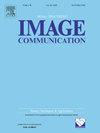Three-domain joint deraining network for video rain streak removal
IF 2.7
3区 工程技术
Q2 ENGINEERING, ELECTRICAL & ELECTRONIC
引用次数: 0
Abstract
When shot outdoors in rainy weather, a rather complex and dynamic changed rain streak layer will have to be added to an original clean video, greatly degrading the performance of advanced outdoor vision systems. Currently, some excellent video deraining algorithms have been proposed and produce good results. However, these approaches neglect the joint analysis of relations in three important domains of videos, where it is widely known that video data certainly has intrinsic characteristics in temporal, spatial, and frequency domains, respectively. To address this issue, in the paper we propose a Three-domain Joint Deraining Network (TJDNet) for video rain streak removal. It composes of three network branches: temporal-spatial-frequency (TSF) branch, temporal-spatial (TS) branch, and spatial branch. In the proposed TJDNet, to capture spatial property for the current frame, is the common goal of these three branches. Moreover, we develop the TSF branch to specially pursue temporal-frequency relations between the wavelet subbands of the current frame and those of its adjacent frames. Furthermore, the TS branch is also designed to directly seize temporal correlations among successive frames. Finally, across-branch feature fusions are employed to propagate the features of one branch to enrich the information of another branch, further exploiting the characteristics of these three noteworthy domains. Compared with twenty-two state-of-the-art methods, experimental results show our proposed TJDNet achieves significantly better performance in both objective and subjective image qualities, particularly average PSNR increased by up to 2.10 dB. Our code will be available online at https://github.com/YanZhanggugu/TJDNet.
视频雨纹去除的三域联合训练网络
在雨天室外拍摄时,必须在原始的干净视频中添加一个相当复杂和动态变化的雨条纹层,这大大降低了先进的室外视觉系统的性能。目前,已经提出了一些优秀的视频脱轨算法,并取得了良好的效果。然而,这些方法忽略了对视频三个重要领域关系的联合分析,众所周知,视频数据在时间域、空间域和频域分别具有内在特征。为了解决这一问题,本文提出了一种用于视频雨纹去除的三域联合训练网络(TJDNet)。它由三个网络分支组成:时空频率分支(TSF)、时空分支(TS)和空间分支。在建议的tjnet中,捕获当前框架的空间属性是这三个分支的共同目标。此外,我们开发了TSF分支,专门研究当前帧的小波子带与其相邻帧的小波子带之间的时间-频率关系。此外,TS分支也被设计成直接捕捉连续帧之间的时间相关性。最后,利用跨分支特征融合传播一个分支的特征,以丰富另一个分支的信息,进一步利用这三个值得注意的领域的特征。实验结果表明,与22种最先进的方法相比,我们提出的TJDNet在客观和主观图像质量方面都取得了显着改善,特别是平均PSNR提高了2.10 dB。我们的代码将在https://github.com/YanZhanggugu/TJDNet上在线提供。
本文章由计算机程序翻译,如有差异,请以英文原文为准。
求助全文
约1分钟内获得全文
求助全文
来源期刊

Signal Processing-Image Communication
工程技术-工程:电子与电气
CiteScore
8.40
自引率
2.90%
发文量
138
审稿时长
5.2 months
期刊介绍:
Signal Processing: Image Communication is an international journal for the development of the theory and practice of image communication. Its primary objectives are the following:
To present a forum for the advancement of theory and practice of image communication.
To stimulate cross-fertilization between areas similar in nature which have traditionally been separated, for example, various aspects of visual communications and information systems.
To contribute to a rapid information exchange between the industrial and academic environments.
The editorial policy and the technical content of the journal are the responsibility of the Editor-in-Chief, the Area Editors and the Advisory Editors. The Journal is self-supporting from subscription income and contains a minimum amount of advertisements. Advertisements are subject to the prior approval of the Editor-in-Chief. The journal welcomes contributions from every country in the world.
Signal Processing: Image Communication publishes articles relating to aspects of the design, implementation and use of image communication systems. The journal features original research work, tutorial and review articles, and accounts of practical developments.
Subjects of interest include image/video coding, 3D video representations and compression, 3D graphics and animation compression, HDTV and 3DTV systems, video adaptation, video over IP, peer-to-peer video networking, interactive visual communication, multi-user video conferencing, wireless video broadcasting and communication, visual surveillance, 2D and 3D image/video quality measures, pre/post processing, video restoration and super-resolution, multi-camera video analysis, motion analysis, content-based image/video indexing and retrieval, face and gesture processing, video synthesis, 2D and 3D image/video acquisition and display technologies, architectures for image/video processing and communication.
 求助内容:
求助内容: 应助结果提醒方式:
应助结果提醒方式:


